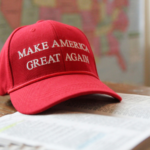Black Americans and allies have staged mass protests across the country in the weeks since George Floyd’s death.
Protesters, which include a significant number of clergy, are expressing righteous anger and demanding justice long denied.
How has the Trump administration responded to calls for justice?
Last week, Attorney General William Barr ordered police to break up peaceful protesters outside the White House in Lafayette Square using what appeared to be tear gas (though the White House continues to deny this) and flash grenades.
Police dispersed the protesters to clear the way for President Trump as he walked across the street to St. John’s Episcopal Church.
He posed for pictures, holding up a Bible in front of the historic church. These photos were used later for a promotional video put out by the White House.
President Trump’s staged demonstration of piety has sparked public outrage. It has been denounced by politicians on both sides of the aisle and by leaders of various faith traditions.
President Trump has since made clear he is not troubled by this criticism. He did not intend to provide comfort in this time of tumult.
Instead, the president’s visit was meant to send a message to a vocal minority of Christians who seek political power.
This is not the first time religious symbols have been appropriated in demonstrations of authority.
Christian nationalism has long used the language and trappings of religion to back their radical political agenda.
Christian nationalism is a collection of myths, symbols and narratives that seek to merge national identity and Christian identity as one.
Its proponents are overwhelmingly white, with some incorporating a racial hierarchy into their vision for America.
Particularly since the election of President Trump, this ideology continues to gain momentum in the United States.
The political influence of the Christian nationalist movement was on full display in Lafayette Square last week.
Hundreds of protesters had gathered to peaceably call for justice and protection from police brutality for black Americans.
Instead of listening to their grievances, Barr instructed the area to be cleared for Trump’s entourage.
This was no mistake – authoritarianism and the use of force are central to Christian nationalism.
In this case, President Trump acted as their champion, clearing the “them” of black Americans for his “us” of white Christian nationalists.
The president’s urging to use force to “dominate” protesters, who he has called “lowlifes, losers and thugs,” is steeped in racism, and is a signal to the Christian radical right that he is willing to use violence on their behalf.
During the photo shoot, the president posed while holding a Bible aloft in front of St. John’s.
When the president was asked if it was his Bible, he replied it was “a Bible.” He left without entering St. John’s and never informed church leadership of his visit.
To St. John’s clergy, this seemed to underscore the impersonal nature of the president’s visit.
When learning of the president’s actions, Bishop Mariann Edgar Budde of the Episcopal Diocese of Washington, D.C., said, “Let me be clear: The president just used a Bible, the most sacred text of the Judeo-Christian tradition, and one of the churches of my diocese, without permission, as a backdrop for a message antithetical to the teachings of Jesus.”
For the purposes of the president’s message, the consent of the church and its congregants was immaterial.
Both St. John’s church and the Bible were props to signal his support of the Christian radical right.
President Trump does not conduct himself in a way one usually associates with a man of faith.
Regardless, President Trump’s supporters have stood by him through scandals and incivility by invoking “vessel theology” – in which an unlikely “vessel” is chosen by God to fulfill an important purpose.
If this is the case, his supporters argue, then Trump’s presidency is infallible for it has been ordained God.
In reality, the president’s relationship with the radical right is more transactional than theological.
The president will support their agenda, and, in turn, they will do everything within their power to keep him in office.
On June 1, the president made clear he is willing to use violence to send a message to both his critics and his supporters.
This message is deeply troubling. Escalating authoritarian measures will primarily impact communities of color and will have dangerous implications for the future of our democracy.
Symbols carry meaning that have the power to move people to action. George Floyd’s name has become a rallying cry for black Americans who have suffered centuries of systemic racism.
Allies are pledging to use their privilege to lift the voices of black American protesters.
As President Trump wields Christian symbols as a cover for violence and to broadcast his support to the radical right, Christians everywhere have a moral imperative to reclaim their faith symbols as ones of righteousness and compassion.
Belief without action is hollow, and, so long as well-intentioned Christians remain silent, their symbols will continue to be exploited by the radical right for political gain.
Director of field and organizing at Interfaith Alliance, a national organization dedicated to protecting the integrity of both religion and democracy in America.





